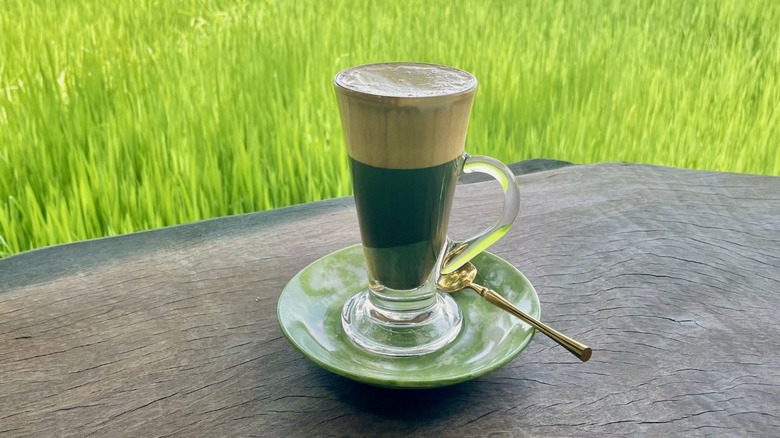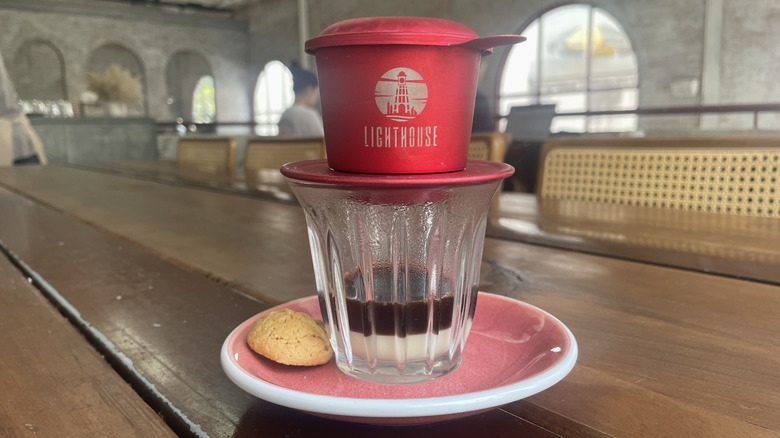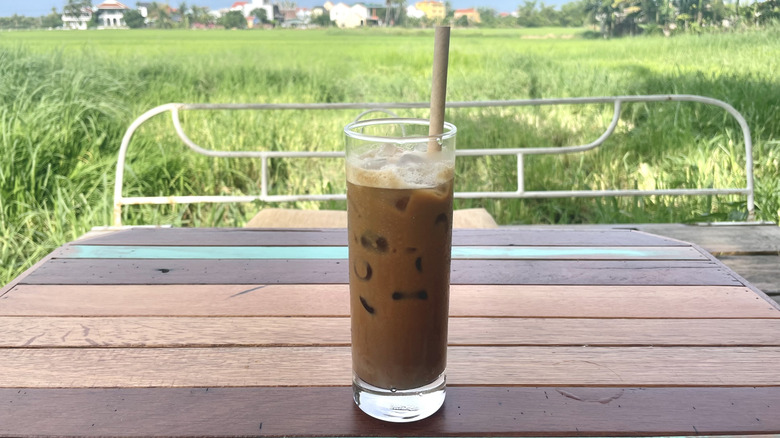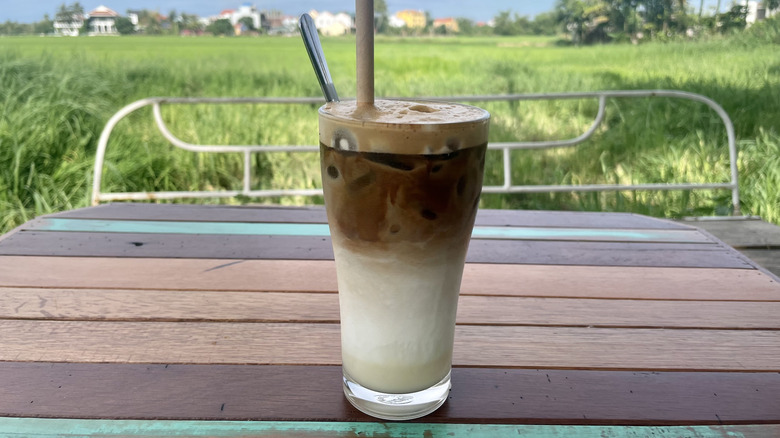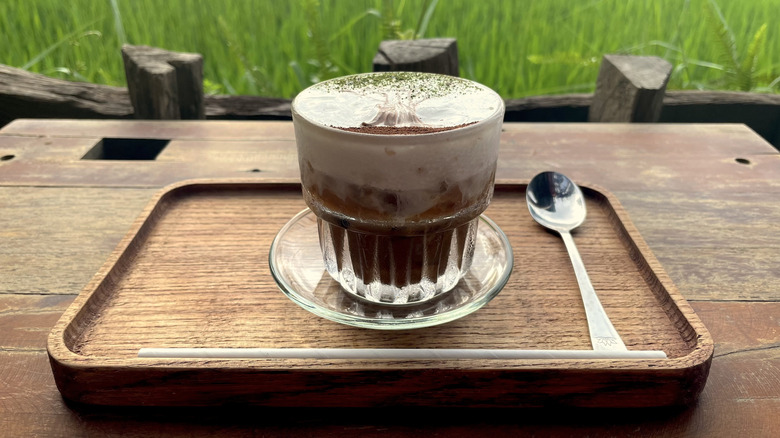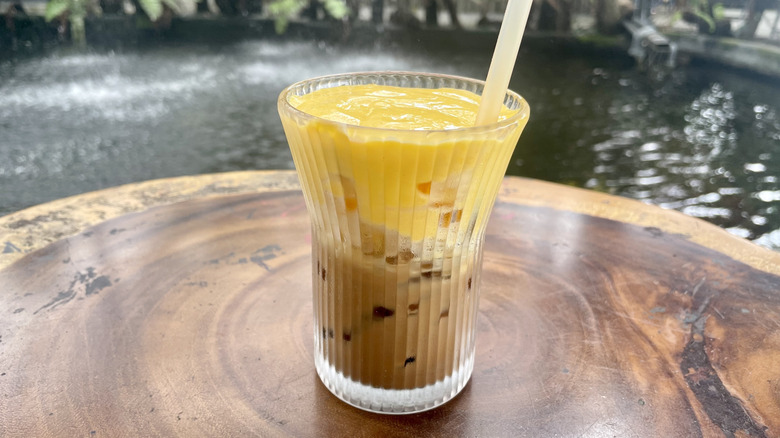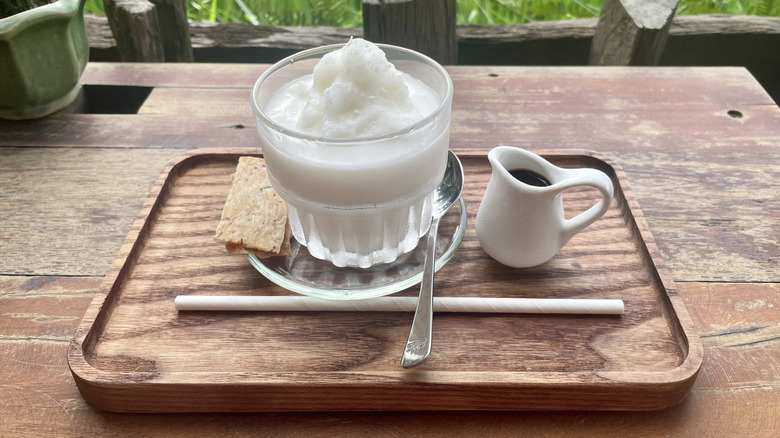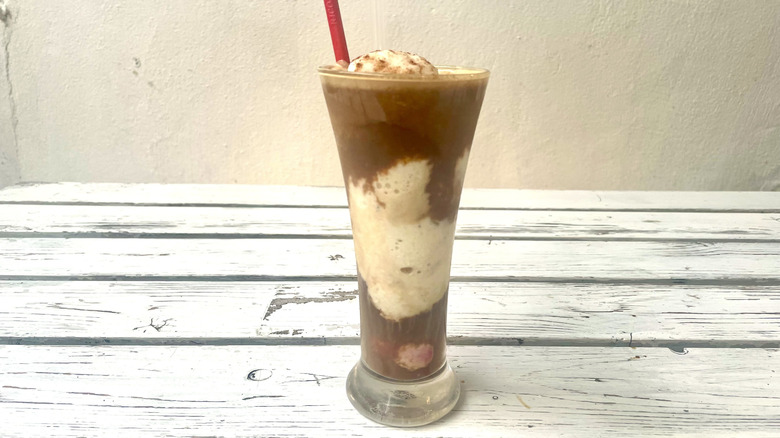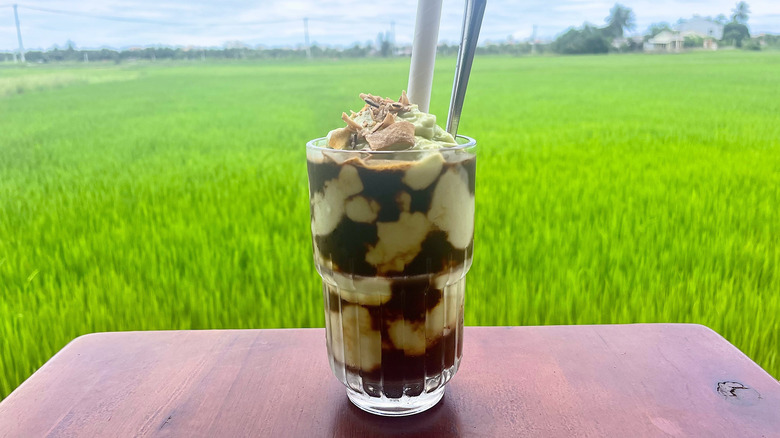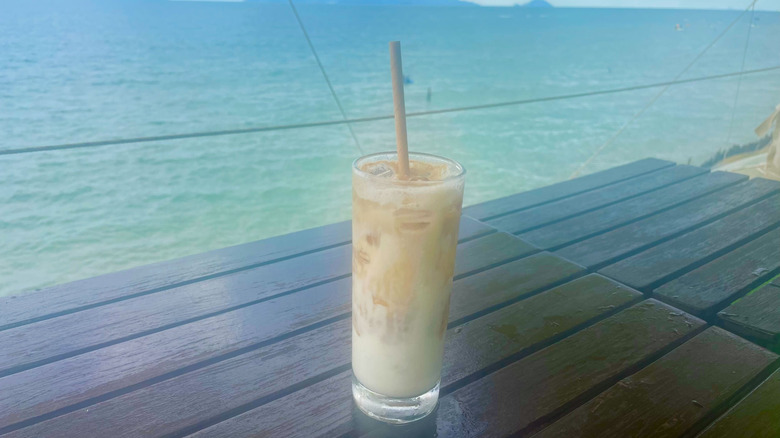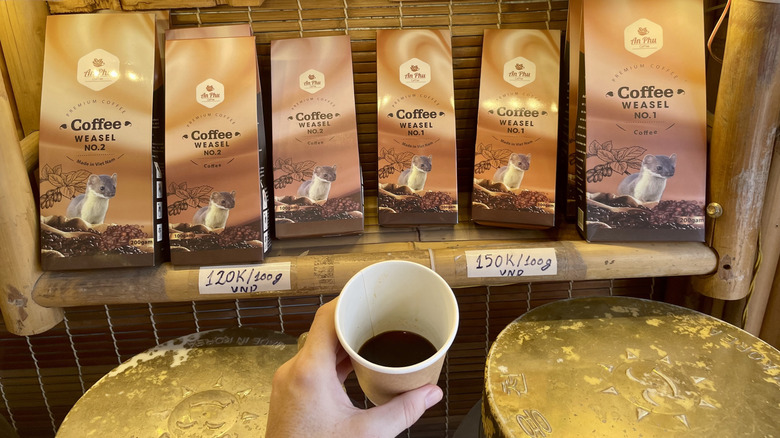10 Vietnamese Coffee Drinks You Can Easily Make At Home
We may receive a commission on purchases made from links.
Vietnam opened my eyes to a whole new coffee world. As the world's second-largest coffee producer, I expected good coffee — but not such a wide variety of tropical coffee shakes and egg-topped concoctions. While tasting the assorted drinks, I realized that not only do these wild combinations somehow work, but they're also surprisingly simple to recreate at home. All you need are the right ingredients and a little insight into Vietnamese coffee culture.
So what makes Vietnamese coffee different? Instead of espresso, they use a phin filter, a pour-over method that evolved from French colonial influence. They also favor Robusta beans, which are known for their rich flavor and higher caffeine content. These two factors are what make Vietnamese coffee so strong. And the sweetness? That comes from sweetened condensed milk, which is present in nearly all of the coffee drinks on this list.
When making Vietnamese coffee drinks at home, you can take the traditional route or experiment with different beans or brewing methods. Adjust the sweetness to taste, and remember that most of these coffee drinks work both hot and iced (with the exception of a few smoothie-like beverages). It's all about discovering what makes your taste buds happy, so keep reading to find a coffee drink that calls your name and embrace that inner barista!
1. Phin coffee
At the heart of all Vietnamese coffee drinks lies phin coffee — not exactly a drink, but a brewing method using a metal filter placed directly over the cup. If you truly want to replicate Vietnamese coffee drinks, you can purchase this Nguyen Coffee Supply Original Phin Filter in three different sizes, with the 4-ounce single-serving being the most traditional.
Vietnamese black coffee (ca phe den) is the foundation for the rest of the drinks on this list. To make a cup, preheat the phin by rinsing it with hot water. Coffee should be a medium-fine grind, like sea salt, so the water can filter through at just the right momentum. Drop 4 teaspoons of grinds into the phin, place it over your cup, then add just enough water to cover the coffee, allowing the grounds to bloom for a few minutes. Blooming creates a smoother coffee because it releases carbon dioxide that gets trapped during the roasting process. Then, top it with ⅓ cup of hot water, close the lid, and let the magic begin.
It takes about five minutes for the coffee to filter, resulting in a small but mighty brew. This obviously isn't your standard, American-style cup of joe. It's also not quite as concentrated as an espresso. Instead, it has a smooth, robust flavor and a consistency somewhere between espresso and drip coffee. And if black coffee is too strong, a little sweetened condensed milk takes the edge off — but more on that below.
2. Vietnamese milk coffee
Vietnamese milk coffee is phin coffee with sweetened condensed milk. Although simple, this two-ingredient drink is rich in both flavor and history. Back in the 1800s, French colonizers brought their coffee obsession to Vietnam, complete with the expectation of fresh milk. Since fresh milk was not readily available, it was replaced by the much more shelf-stable sweetened condensed milk. This dairy dilemma ended up being a blessing in disguise, because Vietnamese milk coffee is renowned for its thick caramel sweetness.
In Vietnam, this coffee drink is called ca phe sua (milk coffee) in the south and ca phe nau (brown coffee) in the north. Vietnamese coffee is strong stuff, but sweetened condensed milk provides the perfect contrast to the bitterness. Though it's still a highly caffeinated drink, neither ingredient overpowers the other. And when black coffee and condensed milk are completely mixed, the drink takes on a brown color, making the northern name quite appropriate.
You can use sweetened condensed milk directly from the can or make sweetened condensed milk at home by simmering milk and sugar. Then, simply drop a spoonful or two into your coffee cup before brewing. As the coffee drips through it gently softens the milk, giving it a melt-in-your-mouth texture. For hot coffee, serve it with a stirring spoon, but if you prefer iced Vietnamese coffee, mix the hot coffee and condensed milk first and pour over ice.
3. Bac xiu
Bac xiu takes Vietnamese milk coffee and adds more milk — but this time, the fresh stuff. It's often called "Vietnamese white coffee" because it has such a high proportion of fresh milk, which is entirely deliberate if you look at the history. Vietnamese coffee has always been strong, but not everyone could handle the bitterness. To tame the flavor and potency, baristas in Saigon's Chinatown started adding a hefty portion of fresh dairy milk. This tradition began in the early 20th century, and has spread throughout the country since.
While originally served hot, most people now go for the iced version because, let's face it, Vietnam gets hot! To make iced bac xiu, mix 3 tablespoons of condensed milk, 4 ounces of fresh milk, and ½ cup ice in a cocktail shaker. Shake vigorously and pour it into a glass. Add 4 ounces of chilled phin coffee on top for a gorgeous layered look.
Before consuming, you'll want to give this drink a good stir to mix the flavors. When it comes to taste, the primary player is undeniably the fresh milk. You also get significant sweetness with a slight hint of bitterness. Just as history suggests, this drink is ideal for those who prefer smooth, creamy coffee, but truthfully, it's a milk lover's delight more than anything.
4. Salt cream coffee
Ca phe muoi, which translates to "salt coffee," is a relatively new invention born in Hue, Vietnam's ancient capital. In an interview with CNN Travel, cafe co-owners Ho Thi Thanh Huong and Tran Nguyen Huu Phong explained, "We created salt coffee in 2010 when we opened our first Ca Phe Muoi coffee shop." They wanted to set themselves apart from the usual cafes offering coffee with sugar or milk, so they added a completely unexpected element: salt. The tactic worked, and pretty soon, ca phe muoi became a nationwide obsession.
If the thought of salt in your coffee is off-putting, keep an open mind. The flavor of salt cream coffee is surprisingly tasty, and the drink somehow strikes the perfect harmony of sweet, salty, and bitter notes. However, it's not just about adding a pinch of salt to your latte. The secret lies in the whipped salt cream that tops the drink.
Start by whipping 7 ounces of heavy cream and 1 teaspoon of salt into a dense foam (for extra sweetness, include a tablespoon of condensed milk). Pour coffee into a glass, stirring in condensed milk to taste. Top it with the salt cream and sprinkle with cinnamon or cacao. This beverage can be hot or iced, but however you serve it, grab a spoon so you can sample the creamy topping first. And fair warning to fellow taste-testers: While this coffee drink is addictive, it's a bit too rich for an everyday affair.
5. Egg coffee
Adding eggs to coffee sounds like a breakfast experiment gone wrong, but Vietnamese baristas turned this unlikely combo into a culinary masterpiece. Back in the 1940s, when post-war milk shortages had people scrambling for alternatives, Nguyen Van Giang, a bartender at Hanoi's Metropole Hotel, had a clever solution to replace milk in coffee drinks. He whipped egg yolk with condensed milk and sugar until it became thick and frothy, then crowned it over phin coffee.
To make this liquid gold, use one egg yolk and 2 teaspoons of sweetened condensed milk. Whisk those ingredients to make your topping, or add extras like sugar, vanilla, and even a touch of butter if desired. Gently pour the cream over hot or iced coffee. Sprinkle cinnamon or cacao on top, but don't immediately stir. The natural layering is one of my favorite qualities about this drink, and that golden cream floating over dark coffee is definitely Instagram-worthy.
While I've sampled egg coffee, or ca phe trung, hot and iced, the hot version wins every time. It's often served in a hot water bath, and aside from being more aesthetically pleasing, the warmth softens the egg cream, letting the flavors meld together. Meanwhile, the cold version simply requires adding ice to the coffee base. It maintains distinct layers, and the cream has a thicker, almost marshmallow consistency rather than being a smooth foam. When it comes to flavor, both versions remind me of a decadent dessert. Think custard-meets-coffee with a Vietnamese twist.
6. Coconut coffee
Coconut coffee reportedly originated in coastal Vietnam, which makes complete sense. Vietnam is one of the biggest producers of coconuts, and in a tropical location, what better way to cool off and get caffeinated than with coconut coffee? This creamy, refreshing beverage is essentially the Vietnamese version of an affogato, with freshly-made ingredients.
This recipe is easy replicate at home and uses coffee, coconut milk, and ice. Choose canned coconut milk over cartons for thick consistency and intense coconut flavor. Brew coffee and shake it with ice or let it chill in the fridge. For two servings, blend ¼ cup of coconut milk with 2 cups of ice. Coconut milk and coconut cream can be used interchangeably here, with the latter producing a richer result. Want it traditional? Blend in ¼ cup of sweetened condensed milk, because let's face it, the Vietnamese are obsessed with the stuff. Vegans can swap in coconut condensed milk. Either way, top the drink with dried coconut flakes for a nice crunch.
You can mix everything in a glass, but I prefer serving it affogato-style. Pour the coconut mixture first, then add coffee for beautiful black-and-white layers. This beverage exceeds expectations and hits oh-so-right on a hot summer's day. It's super refreshing in a way that's hard to put your finger on. The coconut base is not quite ice cream, not quite slushy, but somewhere in between. It manages to feel indulgent while still being light on your palate.
7. Banana coffee
Banana coffee offers yet another tropical twist on traditional coffee. It's made by blending one banana, 1 cup of fresh dairy milk, 1 tablespoon of sweetened condensed milk (or simple syrup), 1 cup of cold brew coffee (or chilled phin), and ice. Sprinkle with cinnamon and cacao, grab a spoon and straw, and you've got two servings ready to share.
When I first tried this beverage, I couldn't taste the banana through the straw alone. By the time it hit my tongue, it was too watered down. After experimentation, I discovered that using a spoon works with the smoothie-like consistency and helps the quintessential banana flavor shine through. There's no artificial nonsense — Vietnamese coffee drinks actually taste like real fruit because they're made with real fruit. However, I couldn't pick up on the condensed milk flavor because the banana's sweetness overpowers the caramel undertones. So if you're trying to eat less sugar, I'd consider leaving the milk out entirely.
While this Vietnamese version is simple, I've spotted some seriously creative renditions online. TikTok user @luckycatfood cooks down overripe bananas with water and sugar to make syrup, then whisks it with cream, sugar, cinnamon, salt, and turmeric (for color). They layer this golden cream over iced ca phe sua (phin-filtered coffee with condensed milk). This elevated version sounds equally delicious hot too, meaning banana coffee could become a year-round option instead of just a summer fling.
8. Avocado coffee
Avocado coffee combines traditional Vietnamese brewing methods with local agriculture, but don't expect typical millennial avocado trends. This is a legitimate drink that's just as delicious as it is gorgeous. For two servings, chill 9 ounces of coffee. Blend one large avocado with ¼ cup of sweetened condensed milk, ½ cup of fresh dairy milk, and a cup of ice. Pour a little coffee into the bottom of your serving glass, add the avocado mixture, then slowly drizzle the remaining coffee on top, letting it seep into the air pockets. Those dark rivers threading through the mint-green cream create a stunning visual effect — but only if you use a clear glass.
The fresh avocado flavor takes center stage, with coffee playing the supporting role. This drink isn't for coffee purists craving bitter kicks. It's more like a creamy, mildly caffeinated morning smoothie. Sweetness depends on the amount of condensed milk you use, and I typically go far lighter than the given recipe. I also highly recommend adding dried coconut flakes on top for a crunchy contrast.
Serve it with thick straws and spoons, as the consistency is denser than any other coffee drink on this list, almost bordering on a meal. It's the perfect hot-weather coffee drink for avocado lovers, offering an excuse to consume this fruit sweet instead of savory.
9. Yogurt coffee
Ca phe sua chua has a ring to it, and if you love both coffee and yogurt, you'll want to familiarize yourself with this phrase. This tangy twist combines ⅓ cup of yogurt with 1 tablespoon of sweetened condensed milk, ½ cup of strong, chilled coffee, and ice. You can layer it all for a dramatic visual effect or blend it into a smoothie, depending on your mood.
Yogurt choice matters since you'll be combining it with coffee. I'd steer clear of fruity, sweetened options — but to each their own! Plain yogurt keeps things traditional and mixes well with the other ingredients. If you prefer Greek yogurt, I'd recommend the blender route since the thick consistency doesn't lend itself to sipability.
Taste-wise, this drink is exactly as it sounds — like milk coffee's tangier cousin. Yogurt adds a subtle sweetness and acidity that makes it stand out. However, the yogurt coffee I tried had just one coffee shot, and the yogurt definitely overpowered the caffeine. It's ideal for a yogurt enthusiast who enjoys a little coffee but can't handle much bitterness. For more balance and a stronger buzz, I'd opt for a double shot of coffee.
10. Weasel coffee
Weasel coffee is famous for being made from weasel poop. However, this rumor isn't entirely true since it's not weasels but a similar-looking species called Asian palm civets. But the poop part? That's entirely accurate. These cute little creatures consume only the ripest fruit of the bunch — you could say they cherry-pick coffee cherries. The fruit then ferments in their digestive tracts, where enzymes break down proteins, altering the flavor and reducing bitterness. The coffee beans are then ... well ... excreted before being collected, cleaned, dried, and roasted.
Most cafes in Vietnam don't stock this expensive delicacy, so I tracked down An Phu, a specialty store in Hoi An, where the owner's son walked me through the selection. Civet-processed coffee also comes in different Arabica and Robusta blends. While you're unlikely to find any of these options Stateside, you can purchase this NATURELAND wild weasel coffee online and brew it as you would standard beans.
For testing purposes, I chose a lighter Vietnamese roast, opting for black coffee to get the full experience. My host promised nutty notes with hints of truffle, but honestly, what hit me first was the incredible smoothness. There was very little bitterness or acidity despite the coffee being served black, which let the subtle flavors shine through. The taste was surprisingly mellow; slightly sweet and musky, but refreshingly light compared to Vietnam's typically bold coffee. Overall, I'd say weasel coffee is pleasant and approachable to even the most casual coffee drinkers.
